Latest recommendations
| Id | Title * ▼ | Authors * | Abstract * | Picture * | Thematic fields * | Recommender | Reviewers | Submission date | |
|---|---|---|---|---|---|---|---|---|---|
06 Sep 2023
Validation of a Radio frequency identification system for tracking location of laying hens in a quasi-commercial aviary systemSabine G. Gebhardt-Henrich, Alexander Kashev, Matthew B. Petelle, Michael J. Toscano https://doi.org/10.1101/2023.02.16.528820Tracking large numbers of hens in aviary housing: validation of a Radio Frequency Identification systemRecommended by Anna Olsson based on reviews by Arjen van Putten and Mona Giersberg based on reviews by Arjen van Putten and Mona Giersberg
With the increasing use of cage-free housing systems for laying hens comes the challenge of monitoring the behaviour of individual hens in large enclosures where they can be not only on the floors but on different levels. The aim of the present study by Gebhardt-Henrich et al., (2023) was to validate a Radio Frequency Identification (RFID) system with the capacity to track a large number of hens for different research and applied purposes where behaviour monitoring is relevant, such as heritability estimates for breeding programs. In a housing system with 225 birds per pens, 26 antennae were placed at different locations. All birds in 5 pens were equipped with a glass tag in a custom-developed leg band. For validation purposes, the behaviour of three hens who could move between two pens was also monitored on video. Equipping these hens with colour-coded backpacks made them identifiable on video. Matching the antennae detection of the focal birds with the behaviour observation showed that the antennae were able to detect a hen on the right tier in > 90% of cases, but that match on antenna level was lower. The limitations of the system are also discussed in this concise methods paper that will be helpful to many researchers interested in tracking laying hens in loose housing systems. Gebhardt-Henrich, S.G., Kashev, A., Petelle, M.B., Toscano, M.J., 2023. Validation of a Radio frequency identification system for tracking location of laying hens in a quasi-commercial aviary system. bioRxiv 2023.02.16.528820. ver. 3 peer-reviewed and recommended by Peer Community in Animal Science. https://doi.org/10.1101/2023.02.16.528820
| Validation of a Radio frequency identification system for tracking location of laying hens in a quasi-commercial aviary system | Sabine G. Gebhardt-Henrich, Alexander Kashev, Matthew B. Petelle, Michael J. Toscano | <p>Cage-free housing is increasingly chosen in Europe, North America, and Australia as an animal-welfare friendly farm system for laying hens. However, hens are kept in large numbers in those systems which makes checking for health and welfare dif... | Animal genetics, Animal welfare | Anna Olsson | 2023-02-17 08:54:51 | View | ||
06 Jan 2025
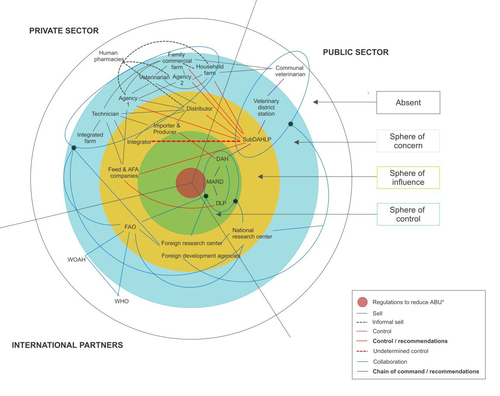
Understanding the implementation of antimicrobial resistance policies in Vietnam: a multilayer analysis of the veterinary drug value chainChloé Bâtie, Nguyen Van Duy, Nguyen Thi Minh Khue, Marisa Peyre, Marion Bordier, Nguyen Thi Dien, Vu Dinh Ton, Flavie Goutard https://doi.org/10.1101/2024.06.27.24309573Bridging the gap in antibiotic regulation within Vietnam's livestock sectorRecommended by François Meurens based on reviews by Rebecca Hibbard and 1 anonymous reviewer based on reviews by Rebecca Hibbard and 1 anonymous reviewer
The reduction of antibiotic use in livestock production, for the different species, has become a critical focus in national action plans across many countries, underscoring the urgent need to tackle this issue to preserve public health and combat antibiotic resistance (Xu et al., 2022; Jacobsen et al., 2023; Bava et al., 2024). Among these efforts, Vietnam's ambitious 2017 livestock plan is notable for its comprehensive regulatory framework aimed at controlling antibiotic use. This framework includes a phased ban on prophylactic antibiotics in animal feed and requires mandatory prescriptions for antibiotic access. Despite these promising regulations, their actual implementation poses significant challenges, with limited data available on their practical application. A recent study led by Batie and collaborators attempts to fill this knowledge gap by examining how these regulations are understood, accepted, and applied by stakeholders in the veterinary drug value chain in both northern and southern Vietnam (Batie et al., 2024). The study employed an interesting iterative stakeholder mapping and analysis approach, organizing a focus group in Hanoi with 12 participants and conducting 39 in-depth semi-structured interviews with a diverse range of stakeholders. These included government authorities, national research bodies, international partners, and private sector representatives. The qualitative analysis aimed to map the veterinary drug value chain, assess stakeholders' technical and social capital regarding regulations, and identify key factors influencing regulatory compliance. This research convincingly unveiled a complex network of 30 stakeholder categories and identified ten crucial factors that affect the implementation of regulations. These factors include stakeholders’ perceptions and understanding of the regulations, the availability of technical guidance, economic conflicts of interest, management inconsistencies, and hurdles such as technical and financial constraints, informal distribution channels, international influence, and consumer demand for safety. Additionally, the collective drive to reduce antibiotic resistance emerged as an influential factor. The comprehensive analysis reveals a pressing insight: although Vietnam's regulatory measures are essential for reducing antibiotic usage, their effectiveness is compromised by barriers such as inadequate local stakeholder involvement and various resource limitations. The study emphasizes the necessity for deeper engagement of local stakeholders in developing and refining these regulations. Furthermore, incorporating innovations from small producers into mainstream practices could be vital in overcoming current challenges. Nonetheless, the study acknowledges several limitations. Most interviews were conducted online owing to the health crisis—a much-needed format for time and budget constraints, albeit with some drawbacks such as reduced direct observations and potential information loss (Namey et al., 2019). The sensitivity of the subject may have led participants to withhold their true opinions, although the researchers attempted to mitigate this bias by interviewing multiple respondents from each category and gathering diverse perspectives. Notably, the study struggled to engage informal stakeholders, which could have enriched the description of the informal value chain. Constraints of time and resources meant that only a single representative from some stakeholder categories was interviewed, suggesting that interviewing additional parties, such as another veterinary district station, might have clarified roles within the drug value chain. The stakeholder identification was initially influenced by the researchers’ familiarity with the Vietnamese context; however, the iterative process helped address this limitation by recruiting new participants based on existing participants' knowledge. Additionally, translation issues may have introduced misunderstandings, potentially leading to an incomplete representation of the veterinary drug value chain, which reflects the situation as of data collection in 2021. For Vietnam to meet its policy objectives and contribute to the global endeavor against antibiotic resistance, it is crucial to reconcile stakeholder discrepancies and promote collaborative innovation. By fostering an inclusive environment for all parties, Vietnam can not only enhance regulatory adherence but also strengthen its commitment to sustainable and responsible livestock farming practices. The study is thoughtfully designed and skillfully executed. Additionally, the authors have made further improvements based on feedback from the journal. Readers will find the article both informative and engaging, providing valuable insights. I highly recommend this original article on the regulatory framework for controlling antibiotic use in Vietnam's livestock production systems. References Batie, C., Duy, N. V., Khue, N. T. M., Peyre, M., Bordier, M., Dien, N. T., et al. (2024). Understanding the implementation of antimicrobial resistance policies in Vietnam: a multilayer analysis of the veterinary drug value chain. medRxiv, 2024.06.27.24309573, ver. 2 peer-reviewed and recommended by Peer Community in Animal Science. https://doi.org/10.1101/2024.06.27.24309573 Bava, R., Castagna, F., Lupia, C., Poerio, G., Liguori, G., Lombardi, R., et al. (2024). Antimicrobial Resistance in Livestock: A Serious Threat to Public Health. Antibiotics 13, 551. https://doi.org/10.3390/antibiotics13060551 Jacobsen, A. B. J. E., Ogden, J., and Ekiri, A. B. (2023). Antimicrobial resistance interventions in the animal sector: scoping review. Front. Antibiot. 2. https://doi.org/10.3389/frabi.2023.1233698 Namey, E., Guest, G., O’Regan, A., Godwin, C. L., Taylor, J., and Martinez, A. (2019). How Does Mode of Qualitative Data Collection Affect Data and Cost? Findings from a Quasi-experimental Study. Field Methods. https://doi.org/10.1177/1525822X19886839 Xu, C., Kong, L., Gao, H., Cheng, X., and Wang, X. (2022). A Review of Current Bacterial Resistance to Antibiotics in Food Animals. Front Microbiol 13, 822689. https://doi.org/10.3389/fmicb.2022.822689
| Understanding the implementation of antimicrobial resistance policies in Vietnam: a multilayer analysis of the veterinary drug value chain | Chloé Bâtie, Nguyen Van Duy, Nguyen Thi Minh Khue, Marisa Peyre, Marion Bordier, Nguyen Thi Dien, Vu Dinh Ton, Flavie Goutard | <p>Reducing antibiotic use in livestock production has been a target for national action plans worldwide. The Vietnamese livestock plan issued in 2017 has, among other objectives, strengthened the regulatory framework for antibiotic use. While a p... |  | Animal epidemiology, Animal health, Farming systems, Veterinary epidemiology , Veterinary science | François Meurens | 2024-07-15 10:47:33 | View | |
24 Mar 2023
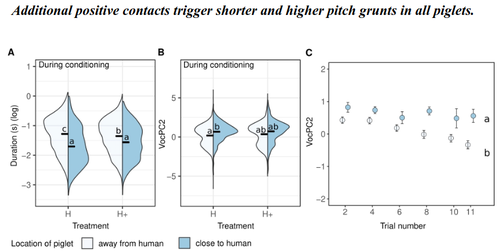
The use of pigs vocalisation structure to assess the quality of human-pig relationshipAvelyne S Villain, Carole Guérin, Céline Tallet https://doi.org/10.1101/2022.03.15.484457Qualitative aspects of grunts vary with pigs' mental statesRecommended by Isabelle Veissier based on reviews by Matteo Chincarini and 1 anonymous reviewerVillain et al., (2023) investigated the structure of vocalisations in piglets in relation to human-animal-relationship. They first established a positive relationship by habituating piglets to be positively handled at weaning or later on after weaning. They then compared the reactions of piglets previously positively handled at weaning to that of non-handled piglets during tests in presence of a human (interacting or not), and also before and after the conditioning period when all piglets received positive contacts. They showed that the duration and frequency of grunts emitted in the presence of the human depends on previous contacts. More specifically, grunts are shorter and higher pitched in pigs that have been positively handled, in line with a positive human-animal relationship which is also observed through proximity of the piglets with the human. The authors concluded that the structure of pig vocalisation can reflect the quality of their relationship with humans. The authors also showed that not only the response to humans is modified by positive contacts but also the general mood of piglets, with piglets positively handled at weaning emitting shorter grunts than non-handled piglets, whatever the context. Another interesting finding is the temporality of behaviour of pigs habituated to positive contacts: during the first tests, they stay close to the human, probably being reassured by the proximity of the human. Then, when tests are repeated, they explore more the test room, using the human as an exploratory basis as already reported in the literature. The hypotheses of the study are clear. The methods are reported in details so that the work is reproducible. The interpretation of results is sound. The manuscript is clearly written. This paper brings new and original knowledge in the field of animals’ emotional responses and human-animal relationship: on the structure of grunts in relation to positive affects (positive emotion, positive mood) and on the temporality of the responses to human presence. I recommend this manuscript for its originality and quality. Isabelle Veissier Villain, A.S., Guérin, C., Tallet, C., 2023. The use of pigs vocalisation structure to assess the quality of human-pig relationship. bioRxiv 2022.03.15.484457, ver. 5 peer-reviewed and recommended by Peer Community in Animal Science. https://doi.org/10.1101/2022.03.15.484457 | The use of pigs vocalisation structure to assess the quality of human-pig relationship | Avelyne S Villain, Carole Guérin, Céline Tallet | <p>Studying human-animal interactions in domestic species and how they affect the establishment of a positive Human-Animal Relationship (HAR) may help us improve animal welfare and better understand the evolution of interspecific interactions asso... |  | Animal behaviour , Animal cognition, Animal welfare | Isabelle Veissier | 2022-03-23 09:34:45 | View | |
09 Apr 2022
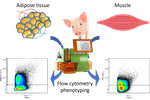
The impact of housing conditions on porcine mesenchymal stromal/stem cell populations differ between adipose tissue and skeletal muscleAudrey Quéméner, Frédéric Dessauge, Marie-Hélène Perruchot, Nathalie Le Floc’h, Isabelle Louveau https://doi.org/10.1101/2021.06.08.447546Housing conditions affect cell populations in adipose and muscle tissues of pigsRecommended by Hervé Acloque based on reviews by 2 anonymous reviewersThe adaptability of livestock to changing environments is based in particular on their genetic characteristics but also on the farming conditions to which they are subjected. However, this last point is poorly documented and little is known about its contribution to environmental challenges. The study by Quéméner and colleagues [1] addresses this question by assessing the effect of two hygiene conditions (good vs poor) on the distribution of cell populations present in adipose and muscle tissues of pigs divergently selected for feed efficiency [2]. The working hypothesis is that degraded housing conditions would be at the origin of an hyper stimulation of the immune system that can influence the homeostasis of adipose tissue and skeletal muscle and consequently modulate the cellular content of these tissues. Cellular compositions are thus interesting intermediate phenotypes for quantifying complex traits. The study uses pigs divergently selected for residual feed intake (RFI+ and RFI-) to assess whether there is a genetic effect associated with the observed phenotypes. The study characterized different stromal cell populations based on the expression of surface markers: CD45 to separate hematopoietic lineages and markers associated with the stem properties of mesenchymal cells: CD56, CD34, CD38 and CD140a. The authors observed that certain subpopulations are differentially enriched according to the hygiene condition (good vs poor) in adipose and skeletal tissue (CD45-CD56-) sometimes with an associated (genetic) lineage effect. This pioneering study validates a number of tools for characterizing cell subpopulations present in porcine adipose and muscle tissue. It confirms that housing conditions can have an effect on intermediate phenotypes such as intra-tissue cell populations. This pioneering work will pave the way to better understand the effects of livestock systems on tissue biology and animal phenotypes and to characterize the nature and function of progenitor cells present in muscle and adipose tissue. [1] Quéméner A, Dessauge F, Perruchot MH, Le Floc’h N, Louveau I. 2022. The impact of housing conditions on porcine mesenchymal stromal/stem cell populations differ between adipose tissue and skeletal muscle. bioRxiv 2021.06.08.447546, ver. 3 peer-reviewed and recommended by Peer Community in Animal Science. https://doi.org/10.1101/2021.06.08.447546 [2] Gilbert H, Bidanel J-P, Gruand J, Caritez J-C, Billon Y, Guillouet P, Lagant H, Noblet J, Sellier P. 2007. Genetic parameters for residual feed intake in growing pigs, with emphasis on genetic relationships with carcass and meat quality traits. Journal of Animal Science 85:3182–3188. https://doi.org/10.2527/jas.2006-590. | The impact of housing conditions on porcine mesenchymal stromal/stem cell populations differ between adipose tissue and skeletal muscle | Audrey Quéméner, Frédéric Dessauge, Marie-Hélène Perruchot, Nathalie Le Floc’h, Isabelle Louveau | <p><strong>Background.</strong> In pigs, the ratio between lean mass and fat mass in the carcass determines production efficiency and is strongly influenced by the number and size of cells in tissues. During growth, the increase in the number of c... |  | Monogastrics, Physiology, Veterinary science | Hervé Acloque | 2021-06-08 17:34:54 | View | |
31 Jul 2023
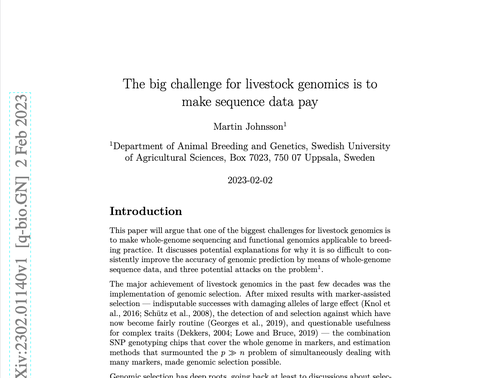
The big challenge for livestock genomics is to make sequence data payMartin Johnsson https://doi.org/10.48550/arXiv.2302.01140The price of sequencing the livestock genomicsRecommended by Marcin Pszczoła based on reviews by Mario Calus and 1 anonymous reviewerUsing sequence data in livestock genomics has often been regarded as a solution to revolutionize livestock breeding (Meuwissen & Goddard, 2010). The main expected benefits were to enhance the accuracy of breeding values, achieve better persistence of the accuracy over generations, and enable across populations or breed predictions (Hickey, 2013). Despite the promised benefits, whole-genome sequencing has not yet been implemented in livestock breeding programs, replacing SNP arrays for routine evaluation. In this work, Johnsson (2023) thoroughly reviewed the literature regarding the implications of whole-genome sequencing and functional genomics for livestock breeding practice. The author discusses the potential applications and reasons for difficulties in their implementation. The author speculates that the main challenge for making using the sequence data profitable is to overcome the problem of the small dimensionality of the genetic data and proposes three potential ways to achieve this goal. The first approach is better modeling of genomic segments, the second inclusion of undetected genetic variation, and the third use of functional genomic information. The paper presents an original and interesting perspective on the current status of the use of sequence data in livestock breeding programs and perspectives for the future. References Hickey,J.M.,2013.Sequencing millions of animals for genomic selection 2.0. Journal of Animal Breeding and Genetics 130:331–332. https://doi.org/10.1111/jbg.12054 Johnsson, M., 2023. The big challenge for livestock genomics is to make sequence data pay. arXiv, 2302.01140, ver. 4 peer-reviewed and recommended by Peer Community in Animal Science. https://doi.org/10.48550/arXiv.2302.01140 Meuwissen, T., Goddard, M.,2010. Accurate prediction of genetic values for complex traits by whole-genome resequencing. Genetics 185:623–631. https://doi.org/10.1534/genetics.110.116590
| The big challenge for livestock genomics is to make sequence data pay | Martin Johnsson | <p>This paper will argue that one of the biggest challenges for livestock genomics is to make whole-genome sequencing and functional genomics applicable to breeding practice. It discusses potential explanations for why it is so difficult to consis... |  | Genomics, Genomic selection | Marcin Pszczoła | 2023-02-03 08:08:39 | View | |
13 Mar 2025
Shade use, welfare and performance of ewes grazing in temperate silvopastures differing in tree densityCécile Ginane, Mickaël Bernard, Véronique Deiss, Donato Andueza, Camille Béral https://doi.org/10.5281/zenodo.10974491Provision of optimal shade for ewes: a question of choiceRecommended by Birte L Nielsen based on reviews by Matteo Chincarini and Pol Llonch based on reviews by Matteo Chincarini and Pol Llonch
As the world slowly (or not so slowly) warms, the ability to regulate heat becomes even more pertinent for livestock kept in enclosed areas. Trees are not always present on land grazed by sheep, and when the pasture has some forestation, the coverage will provide varying degrees of shade. In this study by Ginane et al. (2025), ewes kept in enclosures with different levels of tree cover were observed at different times over a period of three years to investigate the extent to which the animals chose to spend time in the shade. By using fields with very different provision of shade (approximately 1, 40, and 81% shade, respectively), the authors wanted to test the hypothesis that ewes would actively seek out tree shade when the combined temperature and humidity increased – especially if the conditions reached levels associated with heat stress. Even at the lowest provision of shade, which consisted of a single tree in the paddock, all ewes could fit within the shade cast by the tree; but if the distribution of ewes or groups of ewes were random, i.e. independent of shade, the likelihood of these ewes being in the shade by chance was effectively 1%. By factoring in the element of chance, the authors found that mean shade use was greater than the tree canopy cover for the low and medium shade treatments, whereas it didn’t differ from chance for the densely forested treatment. Across treatments, all ewes spent just under 60% of the observation time grazing, and the ewes with the low and medium level of shade actively selected shade for foraging activity, whereas the ewes with over 80% canopy cover avoided it. Across treatments, shade was used primarily for resting and ruminating. Tree cover affected the availability of forage in a negative manner, with more biomass available for ewes in the low shade treatment and significantly less in the high treatment, although this did not translate into significant differences in live weight or body condition score. Using this information, Ginane et al. (2025) calculated the optimal level of tree cover to be somewhere between the low and medium cover, at roughly 30 trees per hectare – preferably spread out over the area to offer different locations of shade and to encourage a natural spread of manure. This longitudinal study of shade use by ewes provides novel and useful information on the positive and negative effects of tree cover in paddocks used to rear ewes with lambs. The authors raise the limitation of the study themselves, and they would have liked to also include observations on non-sunny days, to be able to eliminate place preferences independently of shade availability. But the clever calculation of active shade-selection makes this study easily applicable for use in the assessment of paddock suitability for pregnant ewes. References Cécile Ginane, Mickaël Bernard, Véronique Deiss, Donato Andueza, Camille Béral (2025) Shade use, welfare and performance of ewes grazing in temperate silvopastures differing in tree density. Zenodo, ver.4 peer-reviewed and recommended by PCI Animal Science https://doi.org/10.5281/zenodo.15001481 | Shade use, welfare and performance of ewes grazing in temperate silvopastures differing in tree density | Cécile Ginane, Mickaël Bernard, Véronique Deiss, Donato Andueza, Camille Béral | <p>The study aimed to objectify the importance of trees for sheep welfare by characterising how productive ewes, grazing in temperate mid-mountain pastures, use shade depending on climatic conditions and tree density. The impact of trees on sheep ... | Animal behaviour , Animal welfare, Grazing management , Small ruminants | Birte L Nielsen | 2024-04-03 11:39:54 | View | ||
07 Feb 2022
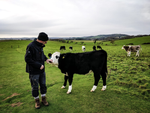
Resilience: reference measures based on longer-term consequences are needed to unlock the potential of precision livestock farming technologies for quantifying this traitFriggens, N. C., Adriaens, I., Boré, R., Cozzi, G., Jurquet, J., Kamphuis, C., Leiber, F., Lora, I., Sakowski, T., Statham, J. and De Haas, Y. https://doi.org/10.5281/zenodo.5215797Measuring resilience in farm animals: theoretical considerations and application to dairy cowsRecommended by Aurélien Madouasse based on reviews by Ian Colditz and 2 anonymous reviewers based on reviews by Ian Colditz and 2 anonymous reviewers
Farm animals differ in their ability to respond to the many environmental challenges they face. Such challenges include infectious diseases, metabolic diseases resulting from inadequate coverage of dietary needs, as well as the diverse consequences of climate change. Various concepts exist to characterise the responses of animals to different types of challenges. This article by Friggens et al. (2022) focuses on resilience, providing a conceptual definition and proposing a method to quantify resilience in dairy cows. The first part of the paper provides a definition of resilience and highlights its differences and relations with the related concepts of robustness, and, to a lesser extent, resistance and tolerance. In essence, resilience is the ability of an animal to bounce back quickly after a challenge of limited duration. On the other hand, robustness is the ability of an animal to cope with conditions that are overall unfavourable. From these conceptual and intuitive definitions, there are several difficulties precluding the design of concrete methods to measure resilience. First, there is some degree of overlap between the concepts of resilience, robustness, resistance and tolerance. Secondly, resilience is a multidimensional concept whereby resilience to a given perturbation does not imply resilience to other types of perturbation, e.g. resilience to a challenge by a specific pathogen does not imply resilience to a nutritional challenge. A further difficulty in the measure of resilience is the fact that different animals may be exposed to challenges that are different in nature and in number. The authors argue that although resilience cannot be measured directly (it should be seen as a latent construct), it is possible to quantify it indirectly through its consequences. In the second part of the paper, the authors propose a method to quantify resilience of individual dairy cows. The method is based on the premise that resilient animals should be kept longer in their herd than non-resilient animals. The main criterion in the evaluation is therefore the ability of cows to re-calve. Each cow that is calving receives a certain number of points, to which, in each lactation, bonus points are added for higher milk production and penalty points are removed for each insemination after the first one, for each disease event and for each day of calving interval above some herd specific value. Therefore, cows have a resilience score in each lactation. They also have a lifetime resilience score obtained by summing the scores for all the lactations, that gets bigger as the cow has more calves, and that also takes the age at first calving into account. In a previous study, Adriaens et al. (2020) showed that higher resilience scores were associated with fewer drops in milk yield and more stable activity dynamics. Starting from theoretical considerations on the notion of resilience, this paper describes a concrete method to quantify animal-level resilience on farm. Such quantification will be useful for breeding and culling decisions. Finally, the general framework to design resilience measures that is presented will be useful to researchers working on the quantification of farm animal resilience using new methods and data sources.
References Adriaens I, Friggens NC, Ouweltjes W, Scott H, Aernouts B and Statham J 2020. Productive life span and resilience rank can be predicted from on-farm first-parity sensor time series but not using a common equation, across farms. Journal of Dairy Science 103, 7155-7171.https://doi.org/10.3168/jds.2019-17826 Friggens, N.C. , Adriaens, I., Boré, R., Cozzi, G., Jurquet, J., Kamphuis, C., Leiber, F., Lora, I., Sakowski, T., Statham, J., De Haas, Y. (2022). Resilience: reference measures based on longer-term consequences are needed to unlock the potential of precision livestock farming technologies for quantifying this trait. Zenodo, 5215797, ver. 5 peer-reviewed and recommended by Peer community in Animal Science. https://dx.doi.org/10.5281/zenodo.5215797 | Resilience: reference measures based on longer-term consequences are needed to unlock the potential of precision livestock farming technologies for quantifying this trait | Friggens, N. C., Adriaens, I., Boré, R., Cozzi, G., Jurquet, J., Kamphuis, C., Leiber, F., Lora, I., Sakowski, T., Statham, J. and De Haas, Y. | <p style="text-align: justify;">Climate change, with its increasing frequency of environmental disturbances puts pressures on the livestock sector. To deal with these pressures, more complex traits such as resilience must be considered in our mana... |  | Precision livestock farming | Aurélien Madouasse | 2021-08-20 15:34:13 | View | |
20 Dec 2021
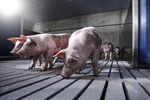
Quantifying growth perturbations over the fattening period in swine via mathematical modellingManuel Revilla, Guillaume Lenoir, Loïc Flatres-Grall, Rafael Muñoz-Tamayo, Nicolas C Friggens https://doi.org/10.1101/2020.10.22.349985An innovative modelling approach to enhance the quality of the quantification of pig resilience during the entire fattening period: Towards an individual pig resilience indexRecommended by Mohammed Gagaoua based on reviews by Arata Hidano, Ludovic Brossard and 2 anonymous reviewers based on reviews by Arata Hidano, Ludovic Brossard and 2 anonymous reviewers
The identification of reliable estimates of growth potential and resilience over the fattening period in large populations is a challenge in actual swine breeding conditions. To overcome this drawback, the study by Revilla et al. 2021 in the frame of precision livestock farming aimed to propose an innovative modelling approach, in addition to previous studies from the same group (Revilla et al. 2019), to enhance the quality of the quantification of pig resilience during the entire fattening period. The authors developed a model that quantifies an “individual pig resilience indicator” based on longitudinal data, for instance body weight, recorded routinely by a commercially available automatic feeding system. Revilla and co-workers considered in their study two mainly commercialised pure pig breeds these being Piétrain including Piétrain Français NN Axiom line (Pie NN) free from halothane-sensitivity (ryanodine receptor gene, RYR1) and Piétrain Français Axiom line positive to this gene and Duroc. Therefore, the authors investigated the potential of improving resilience of swine livestock through inclusion for the first time of an “individual pig resilience indicator” in breeding objectives. A database of 13 093 boars (approximately 11.1 million of weightings) belonging to Pie (n= 5 841), Pie NN (n = 5 032) and Duroc (n= 2 220) finished under ad libitum feeding, high sanitary level and controlled temperature was used to develop robust models. The authors checked the three datasets (for each pig breed) independently to explore the variation and gaps (a data pre-treatment procedure) to ensure high quality data for the modelling approach. Then, they applied the Gompertz model and linear interpolation on body weight data to quantify individual deviations from the expected production, allowing the creation of the ABC index. For the modelling, the authors applied a two-step mathematical model approach by first establishing a theoretical growth curve of each animal, while the second step aimed to build the actual perturbed growth curve. The heritability of the index ranged from 0.03 to 0.04, with similar heritability between Piétrain and Duroc breeds. Moreover, moderate genetic relationships were computed between the proposed index and important phenotypic traits in swine production likely BF100: backfat thickness at 100kg; LD100: longissimus dorsi thickness at 100kg; ADG: average daily gain during control and FCR: feed conversion ratio. Developing models able to capture perturbations during the fattening period is a challenge in swine breeding industry. The model and methodology proposed by the authors in this innovative work (although preliminary and with low heritabilities) would help overcome such limit and facilitate a real implementation at large scale in pig breeding system. The modelling approach further offers an opportunity to develop a selection criterion to improve resilience in swine breeding conditions. To explore the full potential of this modelling approach, a larger database and other factors such as breed, behaviour and feeding behaviour of the animals, rearing practices, management and environment conditions, age… etc. are worthy to consider. In the future, more in depth measurements of behaviour that can be computed for example using computer vision should be desirable to increase the robustness of the proposed model. References Revilla, M., Friggens, N.C., Broudiscou, L.P., Lemonnier, G., Blanc, F., Ravon, L., Mercat, M.J., Billon, Y., Rogel-Gaillard, C., Le Floch, N. and Estellé, J. (2019). Towards the quantitative characterisation of piglets’ robustness to weaning: a modelling approach. Animal, 13(11), 2536-2546. https://doi.org/10.1017/S1751731119000843 Revilla M, Lenoir G, Flatres-Grall L, Muñoz-Tamayo R, Friggens NC (2021). Quantifying growth perturbations over the fattening period in swine via mathematical modelling. bioRxiv, 2020.10.22.349985, ver. 5 peer-reviewed and recommended by Peer Community in Animal Science. https://doi.org/10.1101/2020.10.22.349985 | Quantifying growth perturbations over the fattening period in swine via mathematical modelling | Manuel Revilla, Guillaume Lenoir, Loïc Flatres-Grall, Rafael Muñoz-Tamayo, Nicolas C Friggens | <p>Background: Resilience can be defined as the capacity of animals to cope with short-term perturbations in their environment and return rapidly to their pre-challenge status. In a perspective of precision livestock farming, it is key to create i... |  | Animal genetics, Animal health, Farming systems, Mathematical modelling, Precision livestock farming | Mohammed Gagaoua | 2020-10-26 11:47:08 | View | |
06 Feb 2025
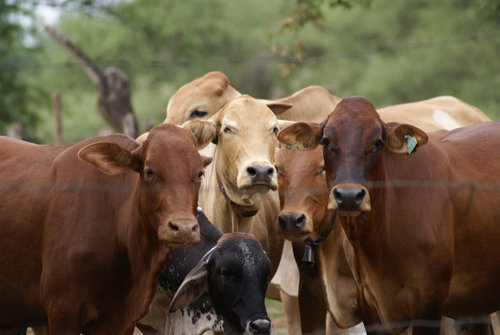
Preferred livestock interventions for small-scale farmers in the Great Limpopo Transfrontier Conservation Area: a demand-driven and participatory approachVimbai Gobvu, Sharai Ncube, Venancio E. Imbayarwo-Chikosi, Robin Bourgeois, Prisca H. Mugabe, Alexandre Caron https://hal.science/hal-04060712What kind of livestock interventions are relevant for small-scale farmers in Great Limpopo Transfrontier Conservation Area?Recommended by Anna Olsson based on reviews by 2 anonymous reviewers based on reviews by 2 anonymous reviewers
The predominant form of agriculture in sub-Saharan Africa is mixed crop and livestock production, typically in extensive systems characterised by low productivity and little input (Tui et al., 2021). Such extensive systems experience many challenges, including access to rangeland and other sources of livestock feed, loss of soil quality, increasingly unpredictable climate but also operational constraints such as access to markets and veterinary care. The work by Gobvu and collaborators (2025) addresses livestock farming sustainability specifically in the context of a Transfrontier Conservation Area (TFCA). A TFCA is defined as part of an ecological region reaching across boundaries of two or more countries and in which there are protected areas as well as resource use areas. TFCAs are founded to facilitate collective management of resources for the benefit of biodiversity as well as socio-economic development (SADC, 2025). Livestock farming in TFCAs face additional challenges arising from the tension between biodiversity protection and resource use, such as wildlife predation on livestock, competition between livestock and wildlife for feed and water as well as spread of infections between livestock and wild animals (Matseketsa et al., 2019; Caron et al., 2013; Cumming, 2011). The paper reports a study that was part of a larger project (EU-ProSuLi project, Caron et al., 2022) aiming at promoting local development and well-being of residents in the Great Limpopo TFCA, with focus on the Sengwe Communal Area in Zimbabwe. The specific aim was to test a methodology for identifying interventions that are aligned with the needs of the local stakeholders (demand-driven interventions. Anticipatory scenario building in the context of workshops was used in combination with individual questionnaires. Community representatives (n=31) were purposefully selected for their expected ability to act as knowledge brokers. A team of 10 facilitators supported the discussion through plenary and group work sessions. The participants were asked to identify factors of change with impact on local community livelihood, and subsequently to vote to select the most influential factors. Different future states for the year 2038, resulting from the impact of the factors of change, were discussed. In a follow-up workshop, participants were asked to propose activities that would support the development towards the most desirable scenario. In addition, a questionnaire was distributed through semi-structured/structured interviews to 126 households in nine villages. Results were largely similar and complementary between the two approaches. Preferred interventions were: restocking herds with locally adapted breeds, training in livestock management, marketing support, feed development and value addition, loan schemes for investment in livestock production and support for animal health interventions to reduce the heavy disease burden. Whereas the participatory process is time consuming and requires considerable human resources, it is important to ensure locally relevant interventions are chosen, and it is in itself part of the process towards successful implementation of these interventions. The study is thoughtfully designed based on previous work by the authors. The paper is well written and has been further improved through the reviewer feedback and revision process. References Caron, A., Miguel, E., Gomo, C., Makaya, P., Pfukenyi, D.M., Foggin, C., Hove, T. and de Garine-Wichatitsky, M., 2013. Relationship between burden of infection in ungulate populations and wildlife/livestock interfaces. Epidemiology & Infection, 141 (7), pp.1522-1535. https://doi.org/10.1017/S0950268813000204 Caron, A., Mugabe, P., Bourgeois, R., Delay, E., Bitu, F., Ducrot, R., Fafetine, J., Fynn, R., Guerbois, C., Motsholapheko, M. and Daré, W., 2022. Social-ecological System Health in Transfrontier Conservation Areas to Promote the Coexistence Between People and Nature. One Health Cases. https://doi.org/10.1079/onehealthcases.2022.0005 Cumming, D. H. M. 2011. Constraints to conservation and development success at the wildlife-livestock-human interface in southern African transfrontier conservation areas: a preliminary review. Wildlife Conservation Society, New York. http://www.wcs-ahead.org/workinggrps_kaza.html Gobvu, V. Ncube, S. Imbayarwo-Chikosi, V.E., Bourgeois, R. Mugabe, P.H. and Caron A. 2025. Preferred livestock interventions for small-scale farmers in the Great Limpopo Transfrontier Conservation Area: a demand-driven and participatory approach. HAL, ver.5 peer-reviewed and recommended by PCI Animal Science. https://hal.science/hal-04060712 Matseketsa, G., Muboko, N., Gandiwa, E., Kombora, D.M. and Chibememe, G., 2019. An assessment of human-wildlife conflicts in local communities bordering the western part of Save Valley Conservancy, Zimbabwe. Global Ecology and Conservation, 20, p.e00737. https://doi.org/10.1016/j.gecco.2019.e00737 Tui, S.H.K., Descheemaeker, K., Valdivia, R.O., Masikati, P., Sisito, G., Moyo, E.N., Crespo, O., Ruane, A.C. and Rosenzweig, C., 2021. Climate change impacts and adaptation for dryland farming systems in Zimbabwe: a stakeholder-driven integrated multi-model assessment. Climatic Change, 168 (1-2), p.10. https://doi.org/10.1007/s10584-021-03151-8 South African Development Community. 2025. Transfrontier Conservation Areas. . Consulted 7 January 2025. https://www.sadc.int/pillars/transfrontier-conservation-areas
| Preferred livestock interventions for small-scale farmers in the Great Limpopo Transfrontier Conservation Area: a demand-driven and participatory approach | Vimbai Gobvu, Sharai Ncube, Venancio E. Imbayarwo-Chikosi, Robin Bourgeois, Prisca H. Mugabe, Alexandre Caron | <p>In southern Africa, residents of Transfrontier Conservation Areas (TFCAs), devoted to biodiversity conservation and local development and well-being, practice small-scale farming in semi-arid environments constrained by the presence of pr... |  | Agricultural sustainability, Cattle production | Anna Olsson | 2023-04-06 12:54:58 | View | |
09 Feb 2024
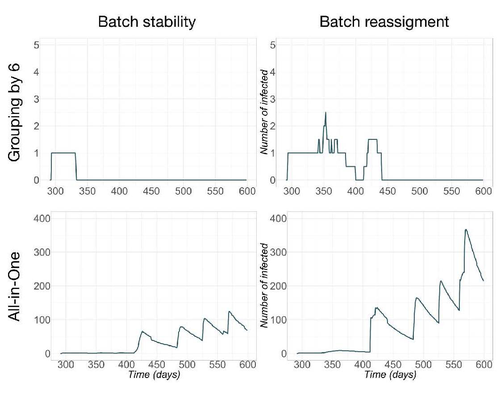
Pig herd management and infection transmission dynamics: a challenge for modellers.Vianney Sicard, Sébastien Picault, Mathieu Andraud https://doi.org/10.1101/2023.05.17.541128Towards models of infection transmission dynamicsRecommended by Marie-Pierre Letourneau Montminy based on reviews by Gustavo Machado and 1 anonymous reviewerEpidemics such as PRRSv-like virus in pig farms has tremendous impact on the competitiveness of swine production. However, its control requires an understanding of the complex interaction between pathogen transmission, disease impact, population dynamics and management. By using mechanistic epidemiological modelling, Sicard et al. (2023) open up a very interesting field of possibilities. This article describes work aimed at assessing the consequences of infections, taking into account the interaction between clinical outcomes and population dynamics. This study shows how this interaction can influence transmission dynamics at the herd level. It highlights the need to further explore this direction, integrating both disease impacts in breeding practices and structural changes in population dynamics, such as pig crossbreeding and grouping methodologies. Reference Sicard V, Picault S, Andraud M (2023) Pig herd management and infection transmission dynamics: a challenge for modellers. bioRxiv, 2023.05.17.541128. ver. 2 peer-reviewed and recommended by Peer Community in Animal Science. https://doi.org/10.1101/2023.05.17.541128
| Pig herd management and infection transmission dynamics: a challenge for modellers. | Vianney Sicard, Sébastien Picault, Mathieu Andraud | <p>The control of epidemics requires a thorough understanding of the complex interactions between pathogen transmission, disease impact, and population dynamics and management. Mechanistic epidemiological modelling is an effective way to address t... |  | Animal epidemiology modelling, Animal health, Bioinformatics, Farming systems, Infectious diseases, Mathematical modelling, Open science, Population dynamics, Veterinary epidemiology | Marie-Pierre Letourneau Montminy | 2023-05-22 15:07:37 | View |
FOLLOW US
MANAGING BOARD
Karol B Barragán-Fonseca
Mohammed Gagaoua
Rachel Gervais
Florence Gondret
Francois Meurens
Rafael Muñoz-Tamayo*
Christian Nawroth
Seyed Abbas Rafat
Yuliaxis Ramayo-Caldas
* Representative









